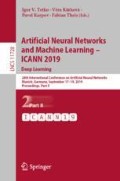Abstract
Class incremental learning is widely applied in the classification scenarios as the number of classes is usually dynamically changing. Meanwhile, class imbalance learning often occurs simultaneously in class incremental learning when the new class emerges. Previous studies mainly proposed different methods to handle this problem. But these methods focus on classification tasks with a fixed class set and cannot adjust the peripheral contour features of the original instance distribution. As a result, the classification performance degrades seriously in an open dynamic environment, and the synthetic instances are always clustered within the original distribution. In order to solve class imbalance learning effectively in class incremental learning, we propose a Central-diffused Instance Generation Method to generate the instances of minority class as the new class emerging, called CdIGM. The key is to randomly shoot direction vectors of fixed length from the center of new class instances to expand the instance distribution space. The vectors diffuse to form a distribution which is optimized to satisfy properties that produce a multi-classification discriminative classifier with good performance. We conduct the experiments on both artificial data streams with different imbalance rates and real-world ones to compare CdIGM with some other proposed methods, e.g. SMOTE, OPCIL, OB and SDCIL. The experiment results show that CdIGM averagely achieves more than 4.01%, 4.49%, 8.81% and 9.76% performance improvement over SMOTE, OPCIL, OB and SDCIL, respectively, and outperforms in terms of overall and real-time accuracy. Our method is proved to possess the strength of class incremental learning and class imbalance learning with good accuracy and robustness.
Access this chapter
Tax calculation will be finalised at checkout
Purchases are for personal use only
References
Chawla, N.V., Bowyer, K.W., Hall, L.O., Kegelmeyer, W.P.: Smote: synthetic minority over-sampling technique. J. Artif. Intell. Res. 16(1), 321–357 (2002). https://doi.org/10.1613/jair.953
Dong, Q., Gong, S., Zhu, X.: Imbalanced deep learning by minority class incremental rectification. IEEE Trans. Pattern Anal. Mach. Intell. PP(99), 1 (2018). https://doi.org/10.1109/tpami.2018.2832629
Huang, C., Li, Y., Chen, C.L., Tang, X.: Learning deep representation for imbalanced classification. In: Computer Vision & Pattern Recognition (2016). https://doi.org/10.1109/cvpr.2016.580
Khan, S.S., Madden, M.G.: One-class classification: taxonomy of study and review of techniques. Knowl. Eng. Rev. 29(3), 345–374 (2014). https://doi.org/10.1017/s026988891300043x
Khoshgoftaar, T.M., Golawala, M., Hulse, J.V.: An empirical study of learning from imbalanced data using random forest. In: IEEE International Conference on TOOLS with Artificial Intelligence, pp. 310–317 (2008). https://doi.org/10.1109/ictai.2007.46
Kuzborskij, I., Orabona, F., Caputo, B.: From n to n+1: Multiclass transfer incremental learning, pp. 3358–3365 (2013). https://doi.org/10.1109/cvpr.2013.431
Lake, B.M., Salakhutdinov, R., Tenenbaum, J.B.: One-shot learning by inverting a compositional causal process. In: International Conference on Neural Information Processing Systems (2013)
Li, F.F., Rob, F., Pietro, P.: One-shot learning of object categories. IEEE Trans. Pattern Anal. Mach. Intell. 28(4), 594–611 (2006). https://doi.org/10.1109/tpami.2006.79
Mu, X., Kai, M.T., Zhou, Z.H.: Classification under streaming emerging new classes: a solution using completely-random trees. IEEE Trans. Knowl. Data Eng. 29(8), 1605–1618 (2016). https://doi.org/10.1109/tkde.2017.2691702
Mu, X., Zhu, F., Du, J., Lim, E.P., Zhou, Z.H.: Streaming classification with emerging new class by class matrix sketching. In: AAAI, pp. 2373–2379 (2017)
Muhlbaier, M.D., Topalis, A., Polikar, R.: Learn ++.nc: combining ensemble of classifiers with dynamically weighted consult-and-vote for efficient incremental learning of new classes. IEEE Trans. Neural Netw. 20(1), 152 (2009). https://doi.org/10.1109/tnn.2008.2008326
Pruengkarn, R., Wong, K.W., Fung, C.C.: Imbalanced data classification using complementary fuzzy support vector machine techniques and smote. In: IEEE International Conference on Systems (2017). https://doi.org/10.1109/smc.2017.8122737
Rabaoui, A., Davy, M., Rossignol, S., Lachiri, Z.: Improved one-class SVM classifier for sounds classification. In: 2007 IEEE Conference on Advanced Video and Signal Based Surveillance, AVSS 2007, pp. 117–122 (2007). https://doi.org/10.1109/avss.2007.4425296
Sebastiani, F.: Machine learning in automated text categorization. ACM Comput. Surv. 34(1), 1–47 (2002). https://doi.org/10.1145/505282.505283
Sheng, C., He, H., Kang, L., Desai, S.: MuSeRA: multiple selectively recursive approach towards imbalanced stream data mining. In: International Joint Conference on Neural Networks (2010). https://doi.org/10.1109/ijcnn.2010.5596538
Wang, S., Minku, L.L., Yao, X.: A learning framework for online class imbalance learning. In: Computational Intelligence & Ensemble Learning (2013). https://doi.org/10.1109/ciel.2013.6613138
Wang, Y., Li, S.: Research and performance evaluation of data replication technology in distributed storage systems. Comput. Math. Appl. 51(11), 1625–1632 (2006). https://doi.org/10.1016/j.camwa.2006.05.002
Wang, Y., Li, X., Li, X., Wang, Y.: A survey of queries over uncertain data. Knowl. Inf. Syst. 37(3), 485–530 (2013). https://doi.org/10.1007/s10115-013-0638-6
Wang, Y., Ma, X.: A general scalable and elastic content-based publish/subscribe service. IEEE Trans. Parallel Distrib. Syst. 26(8), 2100–2113 (2014). https://doi.org/10.1109/tpds.2014.2346759
Wang, Y., Pei, X., Ma, X., Xu, F.: TA-update: an adaptive update scheme with tree-structured transmission in erasure-coded storage systems. IEEE Trans. Parallel Distrib. Syst. 29(8), 1893–1906 (2017). https://doi.org/10.1109/tpds.2017.2717981
Yao, C., Zou, J., Luo, Y., Li, T., Bai, G.: A class-incremental learning method based on one class support vector machine (2018). https://doi.org/10.1088/1742-6596/1267/1/012007
Zhu, Y., Kai, M.T., Zhou, Z.H.: New class adaptation via instance generation in one-pass class incremental learning. In: IEEE International Conference on Data Mining, pp. 1207–1212 (2017). https://doi.org/10.1109/icdm.2017.163
Zhu, Y., Ting, K.M., Zhou, Z.H.: Multi-label learning with emerging new labels. In: IEEE International Conference on Data Mining, pp. 1371–1376 (2017). https://doi.org/10.1109/icdm.2016.0188
Acknowledgements
This work is supported by the National Key Research and Development Program of China (2016YFB1000101), the National Natural Science Foundation of China (Grant No.61379052), the Science Foundation of Ministry of Education of China (Grant No. 2018A02002), the Natural Science Foundation for Distinguished Young Scholars of Hunan Province (Grant No. 14JJ1026). The corresponding author is Yijie Wang and her email is wangyijie@nudt.edu.cn.
Author information
Authors and Affiliations
Corresponding author
Editor information
Editors and Affiliations
Rights and permissions
Copyright information
© 2019 Springer Nature Switzerland AG
About this paper
Cite this paper
Liu, M., Wang, Y. (2019). Central-Diffused Instance Generation Method in Class Incremental Learning. In: Tetko, I., Kůrková, V., Karpov, P., Theis, F. (eds) Artificial Neural Networks and Machine Learning – ICANN 2019: Deep Learning. ICANN 2019. Lecture Notes in Computer Science(), vol 11728. Springer, Cham. https://doi.org/10.1007/978-3-030-30484-3_37
Download citation
DOI: https://doi.org/10.1007/978-3-030-30484-3_37
Published:
Publisher Name: Springer, Cham
Print ISBN: 978-3-030-30483-6
Online ISBN: 978-3-030-30484-3
eBook Packages: Computer ScienceComputer Science (R0)

